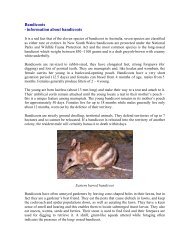Wildlife Preservation Autumn 2012.indd - Wildlife Protection Society ...
Wildlife Preservation Autumn 2012.indd - Wildlife Protection Society ...
Wildlife Preservation Autumn 2012.indd - Wildlife Protection Society ...
Create successful ePaper yourself
Turn your PDF publications into a flip-book with our unique Google optimized e-Paper software.
Austin and Amy Stevens whale-watching off the coast of Fraser Island, Hervey Bay, Queensland<br />
of air from the lungs of an adult<br />
humpback has been timed at 400<br />
kilometres an hour. The water vapour<br />
seen shooting up to seven metres<br />
from the blow-holes is a combination<br />
of moisture from the respiratory tract<br />
and water around the blow-holes<br />
Breaching humpback whale. Photo: Austin Stevens<br />
themselves, vapourised by the force of<br />
the emptied lungs. Considering that<br />
each of a whale’s two lungs is roughly<br />
the size of a small family car, it’s not<br />
surprising that the erupting blow can<br />
often be heard as far as it can be seen<br />
over calm waters.<br />
Since the early days, the humpback<br />
has been recognised as the most<br />
acrobatic of the whales. The most<br />
common manoeuvres include ipper<br />
slapping, tail slapping, head slapping,<br />
spy hopping, arching and breaching.<br />
Nothing is more impressive than<br />
the sight of a full-bodied breach by<br />
a 40-tonne whale, as it launches<br />
itself gloriously out of the water,<br />
with pectoral ns fully extended, to<br />
thunder back below the surface two<br />
seconds later in an explosive wave of<br />
white surging water. This fantastic<br />
feat is achieved by a mere two thrusts<br />
of the incredibly powerful tail.<br />
The spy-hop is often performed close<br />
to a boat. There is little doubt that<br />
whales spy-hop in order to survey<br />
their surroundings, or observe their<br />
observers. Humpbacks have complex<br />
brains, with four lobes compared to<br />
our three. The brains of humpbacks<br />
possess three times as many spindle<br />
neurons as are found in the human<br />
brain, suggesting high emotional<br />
intelligence. Spindle neurons are the<br />
cells involved in processing emotion.<br />
They are responsible for emotional<br />
su ering, and make it possible for us<br />
to feel love. These specialised cells<br />
are unique to humans, great apes,<br />
30 Australian <strong>Wildlife</strong> Vol 2 - <strong>Autumn</strong> 2012





